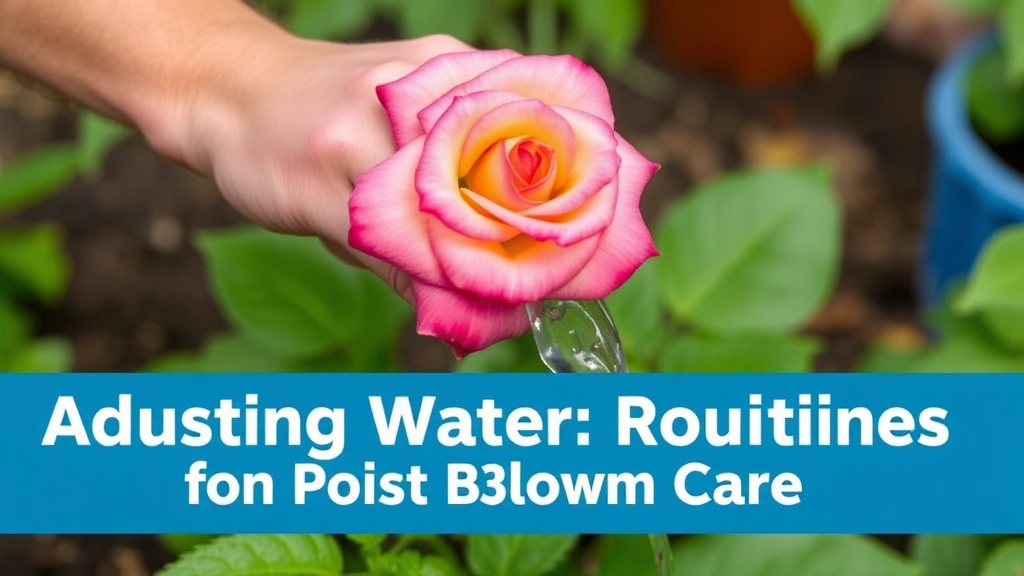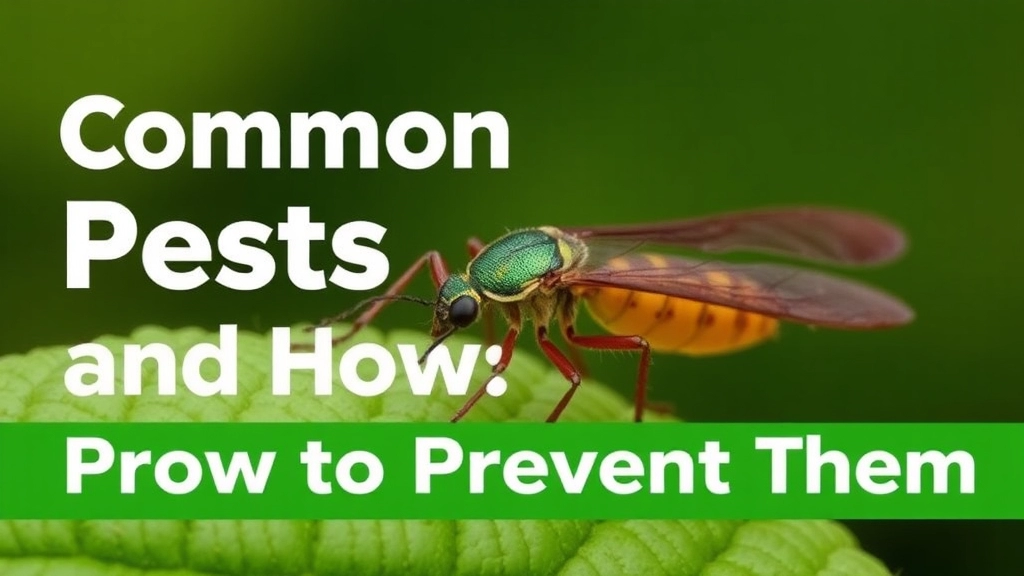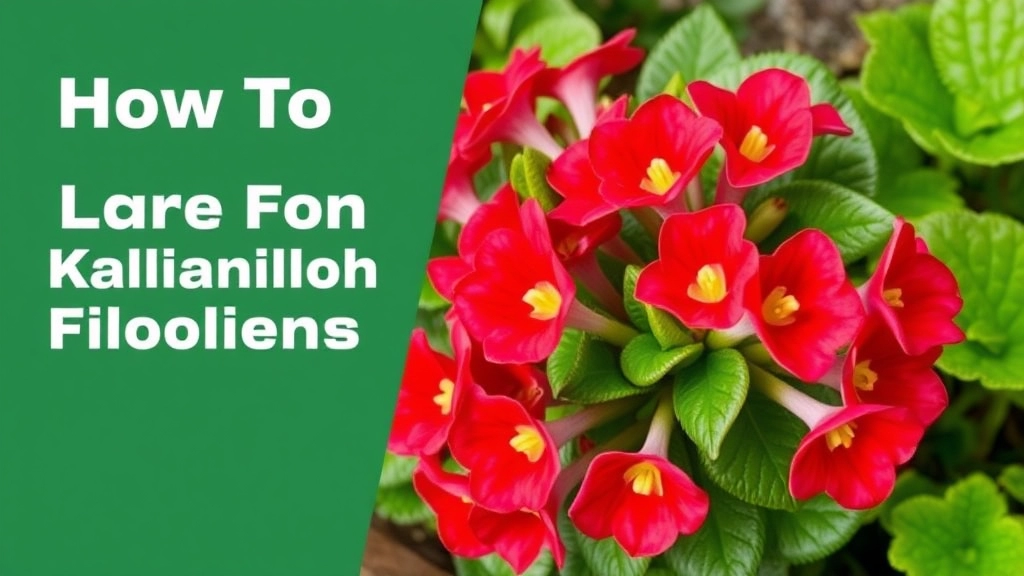Caring for Your Kalanchoe After Flowering
Caring for your Kalanchoe after flowering is essential to keep it healthy and encourage future blooms. First, focus on pruning. Remove any spent flowers and trim back leggy growth to maintain a compact shape. This not only keeps the plant looking tidy but also promotes new growth. Next, adjust your watering routine. Post-bloom, Kalanchoe needs less water, so allow the soil to dry out between watering sessions to prevent root rot.
Light Conditions
Light conditions play a crucial role in the reblooming process. Place your Kalanchoe in a bright spot with indirect sunlight to mimic its natural environment.
Temperature Settings
Proper temperature settings are also vital; keep the plant in a room with temperatures ranging from 15-25°C.
Soil and Repotting
Lastly, consider the soil and repotting. Use a well-draining mix and repot your Kalanchoe if it becomes root-bound. Following these steps ensures your Kalanchoe remains vibrant and ready for its next flowering cycle.
Pruning Your Kalanchoe After Flowering
After the vibrant blooms of your Kalanchoe fade, you might wonder what to do next. Pruning is a crucial step that not only enhances the plant’s appearance but also encourages healthy growth for the next blooming season.
Why Prune?
Pruning your Kalanchoe serves several purposes:
- Promotes New Growth: Removing spent flowers and leggy stems encourages the plant to focus energy on new growth.
- Improves Airflow: Thinning out dense foliage helps prevent diseases by allowing better air circulation.
- Shapes the Plant: Regular pruning keeps your Kalanchoe looking tidy and manageable.
When to Prune?
- Timing: The best time to prune is right after flowering, typically in late winter or early spring.
- Signs: Look for faded flowers and elongated stems; these are indicators that it’s time to get snipping.
How to Prune?
- Gather Your Tools: Use clean, sharp scissors or pruning shears.
- Remove Dead Flowers: Cut off the spent blooms at the base of the stem.
- Trim Leggy Stems: If the stems have grown too long, trim them back to a healthy leaf node.
- Shape the Plant: Aim for a balanced look by selectively removing stems to maintain the plant’s natural shape.
After Pruning Care
Once you’ve pruned your Kalanchoe, it’s essential to adjust your care routine. For more detailed tips on maintaining your plant’s health, you can refer to our Florist Kalanchoe Pruning Guide. Additionally, understanding the common causes of leaf drying can help you troubleshoot and keep your plant thriving.
Adjusting Watering Routines for Post-Bloom Care

So, your Kalanchoe has finished blooming, and now you’re wondering how to keep it thriving. One of the biggest concerns I hear is about watering. It’s crucial to get this right, especially after your plant has put all its energy into those gorgeous flowers.
Here’s what to keep in mind:
- Cut Back on Watering: After flowering, your Kalanchoe doesn’t need as much water. Reduce the frequency to every two to three weeks.
- Check the Soil: Always stick your finger in the soil. If it’s dry an inch down, it’s time to water. If it’s still moist, hold off.
- Water Deeply: When you do water, make sure to soak the soil thoroughly. This encourages strong root growth.
- Use Well-Draining Soil: If your Kalanchoe is in compact soil, it can hold onto moisture longer than needed. Consider using a cactus or succulent mix.
I remember the first time I overwatered my Kalanchoe after it bloomed. It was a real eye-opener! The leaves started to droop, and I panicked. But once I adjusted my watering routine, it perked right back up.
A few tips to remember:
- Always use pots with drainage holes.
- If your plant is in a terracotta pot, it’ll absorb moisture, so you might need to water less frequently.
Getting the watering just right can make a world of difference for your Kalanchoe’s health.
Managing Light Conditions to Encourage Reblooming
After ensuring your Kalanchoe is pruned and well-watered, the next crucial step is managing its light conditions to encourage reblooming.
Many plant owners often wonder, “How can I get my Kalanchoe to flower again?”
The answer lies in understanding its light requirements.
Kalanchoe thrives in bright, indirect sunlight. Here’s how to optimise light conditions:
- Location: Place your plant near a window where it receives plenty of filtered sunlight. A south-facing window is ideal.
- Duration: Aim for at least 12-14 hours of light daily during the growing season. This mimics its natural habitat and helps stimulate new blooms.
- Adjustments: If your plant appears leggy or has sparse blooms, it may not be getting enough light. Consider moving it to a brighter spot.
- Seasonal Changes: As seasons change, adjust the plant’s location to ensure it continues to receive adequate light.
- Artificial Lighting: If natural light is insufficient, using grow lights can be a game-changer. Position them about 12 inches above the plant for optimal results.
By managing these light conditions effectively, you can significantly increase the chances of your Kalanchoe reblooming beautifully. For more detailed care tips, check out our expert tips for thriving Kalanchoe plants. Additionally, if you notice issues like leggy growth, our guide on fixing etiolated Kalanchoe may be helpful.
Ideal Temperature Settings for Dormancy and Growth

After caring for your Kalanchoe post-bloom, you might wonder how temperature impacts its health.
What temperature is best for Kalanchoe?
Kalanchoe plants thrive within specific temperature ranges that promote optimal growth and dormancy.
Temperature Guidelines:
- Growing Season (Spring to Early Autumn):
- Aim for 20°C to 25°C (68°F to 77°F).
- This warmth encourages lush growth and vibrant blooms.
- Dormancy Period (Late Autumn to Winter):
- Lower temperatures to around 10°C to 15°C (50°F to 59°F).
- This cooler environment signals the plant to rest, conserving energy for the next blooming cycle.
Tips for Managing Temperature:
- Avoid Temperature Fluctuations:
- Sudden changes can stress your Kalanchoe.
- Keep it away from drafts, heaters, or air conditioning vents.
- Monitor Humidity Levels:
- Kalanchoe prefers moderate humidity.
- If your home is too dry, consider using a pebble tray with water to maintain moisture without direct contact.
Real-Life Example:
I once had a Kalanchoe that thrived in my sunny kitchen during the warmer months but struggled in the winter. After adjusting the temperature and keeping it in a cooler, well-lit area, it bounced back beautifully, showcasing its vibrant foliage and blossoms.
After your Kalanchoe has finished flowering, you might wonder about the best way to care for its soil and whether it’s time to repot.
Using the right soil is crucial for your plant’s health. Kalanchoes thrive in well-draining potting mixes. Here are some tips to consider:
– **Choose the Right Soil**: Opt for a cactus or succulent mix. These blends allow excess water to drain away, preventing root rot.
– **Check Soil Quality**: If the soil appears compacted or has lost its structure, it’s time for a change. Fresh soil provides essential nutrients.
– **Consider Adding Perlite**: Mixing in perlite can enhance drainage and aeration, promoting healthy root growth.
When it comes to repotting, timing is everything. Here’s when and how to do it:
– **Timing**: Wait until the blooming season is over, ideally in early spring. This allows the plant to recover from flowering before any stress from repotting.
– **Size of Pot**: Choose a pot that is one size larger than the current one. Avoid going too big, as this can lead to water retention issues.
– **Gentle Handling**: When removing the Kalanchoe from its pot, be gentle with the roots. If they are tightly bound, you can tease them apart carefully.
In addition to soil and repotting, it’s essential to consider how these changes can affect your plant’s overall health. For more detailed guidance, check out our [post-flowering care tips for Kalanchoe](https://planthq.org/postflowering-care-tips-for-kalanchoe/) and learn about the [causes and solutions for Kalanchoe leaves curling](https://planthq.org/causes-and-solutions-for-kalanchoe-leaves-curling/).
Common Pests and How to Prevent Them

After nurturing your Kalanchoe through its flowering phase, you might be wondering about those pesky pests that could ruin your hard work.
No one wants to deal with unwanted guests on their plants, right?
Here are some common pests that can affect your Kalanchoe and how to keep them at bay:
- Mealybugs: These little white fluff balls love to hide in leaf joints.
- Prevention: Regularly inspect your plant. If you spot any, wipe them off with a cotton swab dipped in rubbing alcohol.
- Aphids: These tiny green or black bugs can suck the life out of your leaves.
- Prevention: Introduce ladybugs to your indoor garden. They’re natural predators!
- Spider Mites: If you notice fine webbing on your Kalanchoe, you might have a spider mite problem.
- Prevention: Keep humidity levels up. A simple misting can make a big difference.
- Scale Insects: These look like little brown bumps on your leaves.
- Prevention: A strong spray of water can dislodge them, or use insecticidal soap for a more targeted approach.
Tips for Prevention:
- Regular Inspection: Take a few minutes weekly to check for any signs of pests.
- Clean Leaves: Dust can attract pests, so wipe your leaves with a damp cloth.
- Healthy Environment: A well-cared-for plant is less likely to attract pests.
Propagation Methods for New Kalanchoe Plants
After ensuring your Kalanchoe is well cared for post-bloom, you might be wondering how to multiply your lovely plant. Propagation is a rewarding way to expand your collection or share with friends.
Common Propagation Methods:
- Leaf Cuttings:
- Select a healthy leaf from your Kalanchoe.
- Cut the leaf into sections, ensuring each piece is about 2-3 inches long.
- Allow the cut ends to dry for a day or two to form a callous.
- Place the cuttings in well-draining soil and water lightly.
- Keep in bright, indirect light until roots develop.
- Stem Cuttings:
- Choose a healthy stem and cut it just below a node.
- Remove the lower leaves, leaving a few at the top.
- Let the cutting dry for a day to form a callous.
- Plant in soil and water sparingly until roots appear.
- Offsets:
- Kalanchoe plants often produce offsets or “pups.”
- Gently separate these from the parent plant.
- Replant them in their own pots with suitable soil.
- Water lightly and provide bright light for growth.
Tips for Successful Propagation:
- Use clean, sharp tools to avoid infection.
- Ensure your pots have drainage holes to prevent waterlogging.
- Maintain a warm environment to encourage rooting.
By using these methods, you can enjoy the satisfaction of nurturing new Kalanchoe plants. For more detailed steps, you can refer to our Florist Kalanchoe Propagation Guide. Additionally, if you’re interested in learning about different varieties, check out our Comprehensive Kalanchoe Species List.
FAQs on How to Care for Kalanchoe After Flowering
How often should I water my Kalanchoe after it has finished blooming?
After your Kalanchoe has finished blooming, you should reduce watering to every two to three weeks. Always check the soil first; if it’s dry an inch down, it’s time to water.
What type of soil is best for Kalanchoe post-bloom?
Using well-draining soil is crucial for Kalanchoe. A cactus or succulent mix is ideal to ensure the soil doesn’t hold onto moisture longer than needed.
What temperature settings are ideal for Kalanchoe during its dormancy and growth periods?
During the growing season (Spring to Early Autumn), aim for temperatures between 20°C to 25°C (68°F to 77°F). In the dormancy period (Late Autumn to Winter), lower the temperatures to around 10°C to 15°C (50°F to 59°F).
How can I avoid temperature fluctuations for my Kalanchoe?
Avoid placing your Kalanchoe near drafts, heaters, or air conditioning vents to prevent sudden temperature changes, which can stress the plant.
What are common pests that affect Kalanchoe, and how can I prevent them?
Common pests include mealybugs, aphids, spider mites, and scale insects. Regular inspection, maintaining humidity, and cleaning the leaves can help prevent these pests.
How do I deal with mealybugs on my Kalanchoe?
If you spot mealybugs, wipe them off with a cotton swab dipped in rubbing alcohol. Regular inspections can help catch them early.
What should I do if I find aphids on my Kalanchoe?
Introducing ladybugs to your indoor garden can help, as they are natural predators of aphids.
How can I prevent spider mites on my Kalanchoe?
Maintain higher humidity levels by misting your plant regularly. This can help keep spider mites at bay.
What is the best way to remove scale insects from my Kalanchoe?
A strong spray of water can dislodge scale insects, or you can use insecticidal soap for a more targeted approach.
How can I ensure my Kalanchoe stays healthy and pest-free?
Regularly inspect your plant, clean the leaves to remove dust, and maintain a healthy environment to reduce the likelihood of pest infestations.
References
-
Kalanchoe Plant Care: How To Care For A Kalanchoe
-
Kalanchoe Succulent Plant Profile
-
Kalanchoe – How to Grow and Care for Kalanchoe Plants
